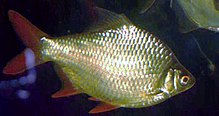Tinfoil barb
| Tinfoil barb | |
|---|---|

| |
| Scientific classification | |
| Domain: | Eukaryota |
| Kingdom: | Animalia |
| Phylum: | Chordata |
| Class: | Actinopterygii |
| Order: | Cypriniformes |
| Family: | Cyprinidae |
| Subfamily: | Cyprininae |
| Genus: | Barbonymus |
| Species: | B. schwanenfeldii
|
| Binomial name | |
| Barbonymus schwanenfeldii (Bleeker, 1853)
| |
| Synonyms | |
|
Barbodes schwanefeldii (lapsus) | |


The tinfoil barb (Barbonymus schwanenfeldii) is a
is frequently misspelled schwanefeldii.Nowadays it is usually placed in the genus
It is distinguishable from other species of the genus in having a red dorsal fin with a black blotch at the tip, red pectoral, pelvic and anal fins, red caudal fin with white margin and a black submarginal stripe along each lobe, and 8 scale rows between dorsal-fin origin and lateral line. Large individuals are silvery or golden yellow while alive with its dorsal fin red and caudal fin orange or blood-red. It grows up to 14 inches (35 cm) in length. Tinfoil barbs have a lifespan of 10 to 15 years.
Originating in the
The tinfoil barb is commercially important in the aquarium hobby trade, as well as commercial aquaculture, subsistence farming, and occasionally as bait. It is usually marketed fresh.
There are no obvious distinguishing characteristics used to determine the sex of the fish. They reproduce by egg scattering of several thousand eggs per spawning. They are not often bred in captivity for the aquarium trade due to their large size.
Parasites
As most fish, the tinfoil barb harbours a number of
In the aquarium
This section is written like a manual or guide. (December 2014) |
The tinfoil barb is a schooling species that prefers to be placed with a number of its own species. It prefers living in water with strong currents similar to those found in their native streams. It is also recommended that they be kept with fish of similar size or larger. Many unwary buy young specimens and find out too late how large the tinfoil barb can grow. The tinfoil barb is often seen in large aquaria as companions to large cichlids e.g. the oscar cichlid,
See also
References
- . Retrieved 15 December 2017
- PMC 10416761.

- Froese, Rainer, and Daniel Pauly, eds. (2006). Barbonymus schwanenfeldii in FishBase. February 2006 version.
- "Barbus schwanefeldi". Integrated Taxonomic Information System. Retrieved April 28, 2004.
- Lambert, Derek J (1997). Freshwater Aquarium Fish. Edison, New Jersey: Chartwell Books. pp. 16. ISBN 0-7858-0867-1.
- Sharpe, Shirlie. "Tinfoil Barb". Your Guide to Freshwater Aquariums. Retrieved December 15, 2004.

